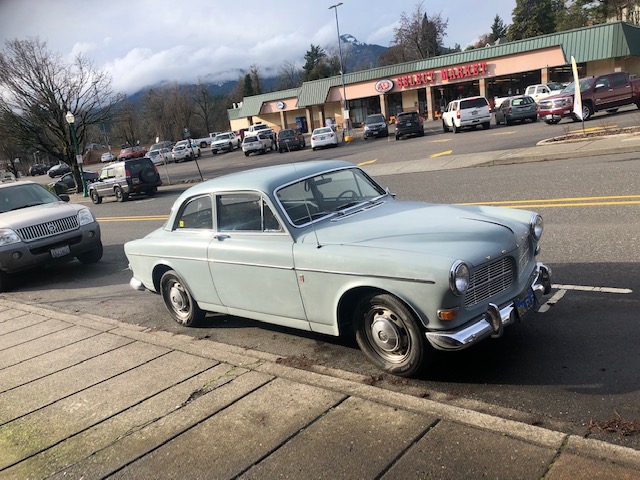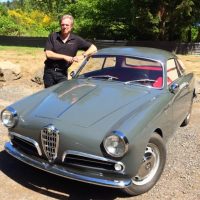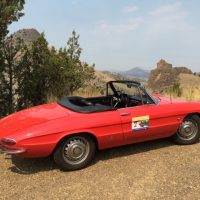
As we shuffle the SCM car collection, one thing has become evident.
With an old car, the most important thing you can do is make sure its suspension is in top shape.
By their nature, sports cars that are now a half-century old have not had easy lives. In addition to being driven hard, nearly every one of them has gone through owners with modest budgets and even more modest mechanical skills. So they have suffered minimalist repairs — often rendered poorly.
There is no joy in driving an old car that wanders all over the road or presents you with a symphony of bumps and clunks. And if driving your old car isn’t fun, what’s the point?
When a car comes into the collection, I always do a couple of things right away. First of all, I have all the suspension bushings inspected, and if there is the slightest question, we replace them.
Most often, suspensions have gradually worn out over the decades the previous owner has had the car. The change has come so slowly that he/she hasn’t even noticed it, and simply accepted the deficiencies as “the way old cars drive.”
That’s not true. When our vintage sports cars were new, they handled better than nearly anything else on the road. What do you think handled better — a1960 MGA or a 1960 Chevrolet?
Bringing an analog suspension up to snuff is not expensive, and almost any shop can do the work. The SCM 1971 Jag taught us to avoid the “upgrade” from OEM rubber to polyurethane bushings. Our experiences with poly have not been good ones. And given the light, limited use our old cars get now, chances are the rubber bushings will outlive us.
“While you are in there,” explore installing modern performance springs that lower a car just slightly, without making a harsh ride. I also suggest a new set of Bilstein or Koni shocks.
I always add a thicker/stiffer front sway bar to keep down body roll in the corners. I am also a fan of rear sway bars, but not everyone agrees with me.
Those looking for maximum performance on the track often prefer no rear bar as they feel a “loose rear end” provides higher cornering speeds.
As I’m driving on the street and not the track, I always opt for a rear bar and less body roll. But that’s my personal preference.
Add a new set of modern radials, and you have a car that will hug the road better than it did when new, without giving up any suppleness of ride thanks to the tall sidewalls on vintage-spec tires.
The final thing I do is inspect the driver’s seat cushion. Often they have collapsed gradually over the years, causing you to sink lower into the car and impairing your view over the hood.
With most analog cars, the solution is simply a matter of installing a new seat cushion. That was less than $75 on each of the three MGBs SCM had in the garage a few years ago.
Granted, your old car will never be able to keep up with a base-level Kia or Hyundai on the twisties. But on the special days you get to drive your car, it will track straight and stay flat in the turns.
By the way, there’s nothing to prevent you from making “Boy Racer” zoom zoom noises as you carve you way through the apexes — even if hitting the advisory caution speeds through the turns remains a distant dream.







Keith ,
Another important thing to do immediately, is to spend a
Half hour UNDER the dash and use simple plastic “Ties”
To tie down ALL wandering gage wires to a post or cable .
This will Help to avoid disappointments , or worse , later !
Just curious, but of all the E-Types available why would SCM’s car collection contain a ’71 model rather than an early year Series 1? I very much enjoy SCM and find it one of the more “discriminating” of the car magazines but find it odd that the collection includes one of the least successful E-Types with regard to design. I suppose I’m somewhat prejudiced since I just completed a 30-month restoration of a ’62 E-Type roadster. Oh well, a chacun son gout. Cheers
a rear bar promotes oversteer/reduces understeer–that’s been my experience thru the years!
Yes, and a front bar increases understeer.
Keith, I whole heartedly agree on this topic. Every old car I’ve owned has required at least a partial if not complete suspension rebuild to make it drivable. I always buy new tires, too, unless the tires on it are high quality name brand of proper size and 5 years old or less. Which I’ve almost never seen…even with newer cars, owners seem to neglect replacing aged tires even if they don’t have a lot of miles on them. Or if they do they’ll mount el cheapo off-brand tires. Dumb.
Keith, i have driven 2 122S Volvos , one 2 door like yours and one Wagen, both stick, never much cared for them BUT do respect the quality build, remember the clickity Click of the lifters,Chuck Coli